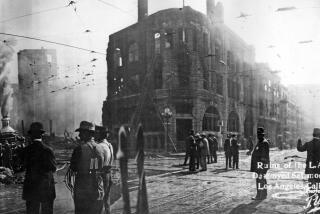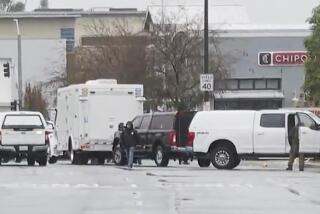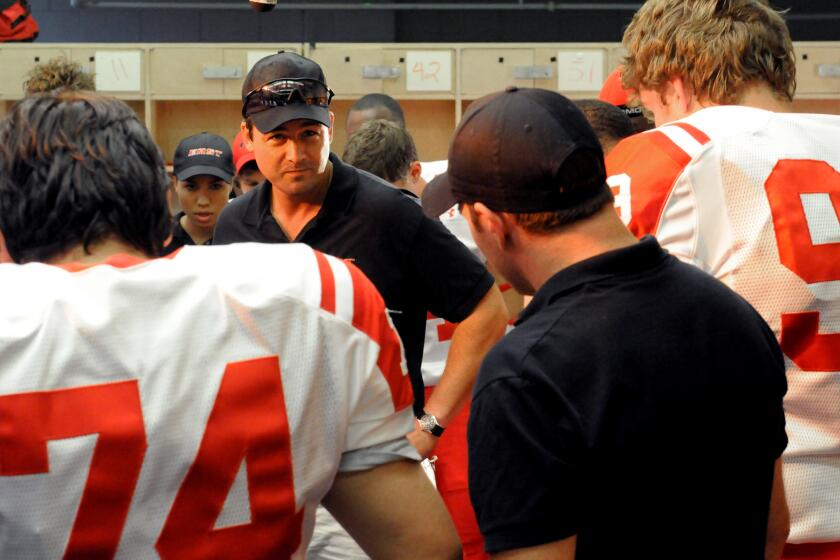Television review: A look back at the Triangle factory fire
With unions under attack and on the march around the country, it’s a good moment to be reminded of why labor had to organize in the first place. On March 25, 1911, a fire at the Triangle Shirtwaist Co. in Manhattan killed 146 workers, most of them young women, and to mark the tragedy’s centenary come two documentaries on the subject. “Triangle Fire” airs on PBS Monday, as part of “The American Experience”; HBO has “Triangle: Remembering the Fire,” coming March 21.
The facts, which should be known in outline at least to all American schoolchildren, are these. The company, which made shirtwaists — blouses, basically — occupied the top three floors of a new, 10-story skyscraper off Washington Square. (The building still stands.) On that day in March, a fire began on the eighth floor, due most likely to a carelessly discarded cigarette; the executives on the 10th floor were alerted by phone, and managed to get across the roof to an adjacent building, but about 300 workers on the ninth floor did not get that message. The fire department arrived quickly, but their ladders reached only to the sixth floor. Many got out before the narrow stairwells became impassible and the only fire escape collapsed; heroic operators kept the elevators running as long as they could; but just as many died, burned in the fire or from the fall, jumping from the windows — in one passed-down family memory, “some of them holding hands, some of them hugging.”
Coming two years after a general strike among garment workers that failed to unionize Triangle (though other shops did unionize), and being the awful event that finally sent reform in motion, this was a pivotal moment in this history of American labor: Frances Perkins, a witness to the fire who would serve on the board set up in its wake to investigate factory conditions in New York state and later become the first female Secretary of Labor, called it “the first day of the New Deal.” The workers were immigrants, largely Jewish and Italian at Triangle and as young as 14, forced by circumstances to work too many hours at too great a pace, with pay docked not only for mistakes, but for the needles they used, and even the electricity. There was no preparation for an emergency — no fire drills, no sprinklers, and one of the exits was locked to keep employees from making off with any scraps.
It will take something out of you, but it’s worth watching both films, which, although they share a lot of material, come at the subject from different directions, in different tones. Of the two, the PBS film is the more scholarly, more traditionally organized and elegantly made. (PBS documentaries can have an elegiac air even when they are only mourning the past.) More time is spent establishing background and social and political context and, though the sympathy is rightly with the victims, there is something like balance attempted. The narration attempts here and there to get inside the head of the Triangle owners, who were, one should note, immigrants themselves: “They saw this union movement as a personal attack on them, an attack on private property, an attack on the liberty at the heart of America’s promise.” This does not sound like old news.
The HBO film is less reserved, built around interviews with descendants not just of victims and survivors, but of a fireman, then-assemblyman Al Smith (a Tammany Hall politician who also served on the panel that investigated working conditions in the state’s sweat shops and became an advocate for reform), and one of the company’s owners. (Susan Blanck Harris says of her forebear, exonerated on a charge of manslaughter, “If my daughter had died in the fire, and he hadn’t been my grandfather, I probably would have shot him.”) Though it is the blunter instrument — it suffers from the odd narrative cliché (“No one was prepared for what was about to happen”) and a rather brutal soundtrack — it is the more immediately moving of the two films, by which I mean it’s the one that had me sobbing rather than merely horribly sad and angry. It gives you a sense of how the fire not only changed history — the history we all swim in — but individual family histories, and how lives become stories that keep wounds fresh across generations. As they should be.
More to Read
The complete guide to home viewing
Get Screen Gab for everything about the TV shows and streaming movies everyone’s talking about.
You may occasionally receive promotional content from the Los Angeles Times.







